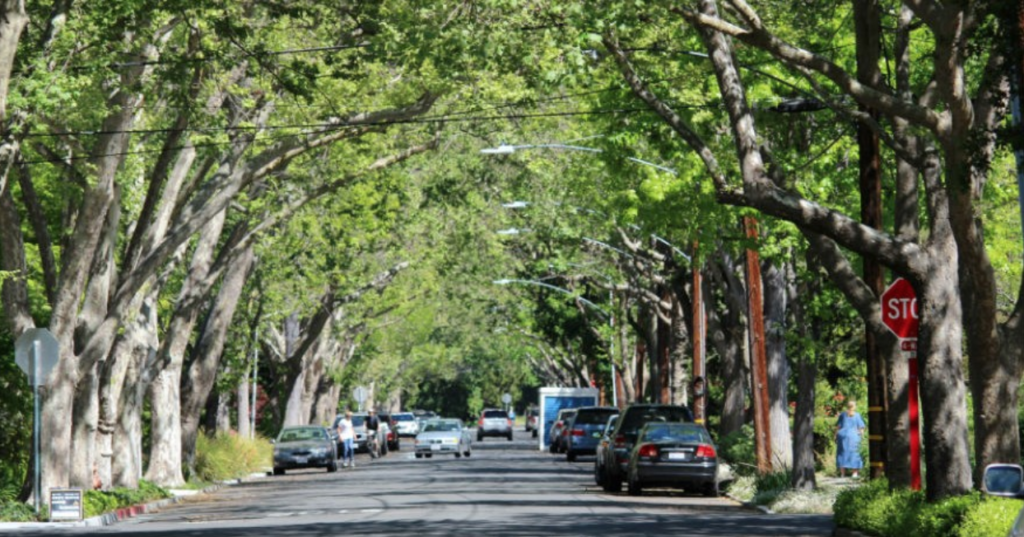- About Us
- Our Work
- Tree Info
- Get Involved
- Blog
- Volunteer
- Support Us
By Canopy Team on July 17, 2020

On the first day of summer, the average temperature in Portola Valley is 70 degrees, while just down the road in Palo Alto the average temperature is 76 degrees. Why are the temperatures in built-up areas like Palo Alto so much warmer than their rural neighbors? The infrastructure of Bay Area cities, including our streets, roofs, and buildings, have a significant impact on the local air temperature. This phenomena of urban areas being hotter than surrounding rural areas is referred to as the urban heat island effect.
Built environments are warmer because of the way that materials such as concrete, glass, and asphalt absorb solar radiation, rather than reflecting it. This is compounded by the lack of shade in many urban areas, which is often due to a lack of trees. In some cities, tall buildings are the greatest source of shade; but these buildings also block wind and store heat in their walls. All of these heating mechanisms are further compounded by air pollution from traffic or industrial activities, which can create a greenhouse effect above cities and trap heat. The heat island effect is especially pronounced in the evenings, when rural areas cool off after sunset while urban areas retain the heat of the day.
The urban heat island effect isn’t just a piece of weather trivia, it is having negative impacts on cities around the world. One issue is the increased use of cooling systems. According to the Environmental Protection Agency, around 5-10% of a community’s electricity demand is used to mitigate the effect of the urban heat island. Increased use of electricity also leads to increased burning of fossil fuels, and the associated emissions of Carbon Dioxide and air pollutants.These pollutants lead to smog and particulate matter that deteriorate the air quality and cause heart and lung diseases. Increased temperatures also have a direct effect on human health. Besides being more uncomfortable, urban heat islands can lead to respiratory issues, cramps, exhaustion, heat stroke, and heat related mortality. High nighttime temperatures, one of the trademarks of a heat island, are especially damaging to health, with hot days followed by hot nights having been found to lead to greater mortality than hot days followed by cool nights. All of these impacts are exacerbated during heat waves, which, along with average daily temperatures, are expected to increase due to climate change.
While the urban heat island effect is a large and serious issue, there are tested and proven steps we can take to address it. One strategy is growing a resilient urban forest, which Canopy actively works towards. Shade trees can reduce the amount of solar radiation that reaches the ground by up to 90% in the summer, and this shading leads to cooler surfaces. Also, the water released by a tree’s leaves and soil leads to cooler air. In the case of oak trees, this can be as much as 40,000 gallons per year! Strategically placed trees can also reduce the amount of light hitting buildings, therefore cooling them down and decreasing the demand for electricity.
When thinking about urban heat islands, it is important to note that not all communities feel the effects of urban heat islands equally. Older adults, children, outdoor workers, people with preexisting health conditions, and low income people are exceptionally vulnerable to the impacts that heat has on health. Studies also indicate that low income neighborhoods are hotter than higher income neighborhoods, meaning that the negative health impacts are concentrated in those areas. Suburban neighborhoods with mature trees are 4-6 degrees cooler than neighborhoods without mature tree cover, while a study examining multiple US cities found that high income neighborhoods have more tree cover than lower income neighborhoods.
The disparity between lower and higher income neighborhoods can be seen locally. East Palo Alto’s canopy cover is half that of Palo Alto, when adjusted for population. Looking at aerial images below of Palo Alto (left) and East Palo Alto (right), the difference in canopy cover is clear. Canopy refers to this as the “green gap”.

Canopy is taking steps to close the green gap by ”prioritizing tree planting, stewardship, education and advocacy in communities where people do not have a thriving urban forest due to limited resources, competing priorities, and historical development and urbanization patterns.” Learn more by reading our complete DEI Policy. Canopy volunteers have planted over 1,000 trees in East Palo Alto through the East Palo Alto Young Tree Program. As these trees mature, they will provide shade and a multitude of health benefits to East Palo Alto residents. Our planting project in south Palo Alto, which has 22% less trees than north Palo Alto, has added hundreds of trees to the neighborhood. By equitably increasing the urban forests of the Midpeninsula, Canopy is addressing the social justice implications of the urban heat island effect.
Urban forests are a powerful tool for mitigating the urban heat island effect, and provide many additional positive benefits. That means that every resident has the power to combat this issue by simply planting a tree. If you are a resident of East Palo Alto or North Fair Oaks and want to help grow your community’s urban forest, sign up for a free tree. Even if you don’t live in one of the listed neighborhoods, consider adding to your urban forest, and be sure to check out Canopy’s guide to tree selection and tree planting (en español también) to find the right tree for your space and make sure that it thrives.